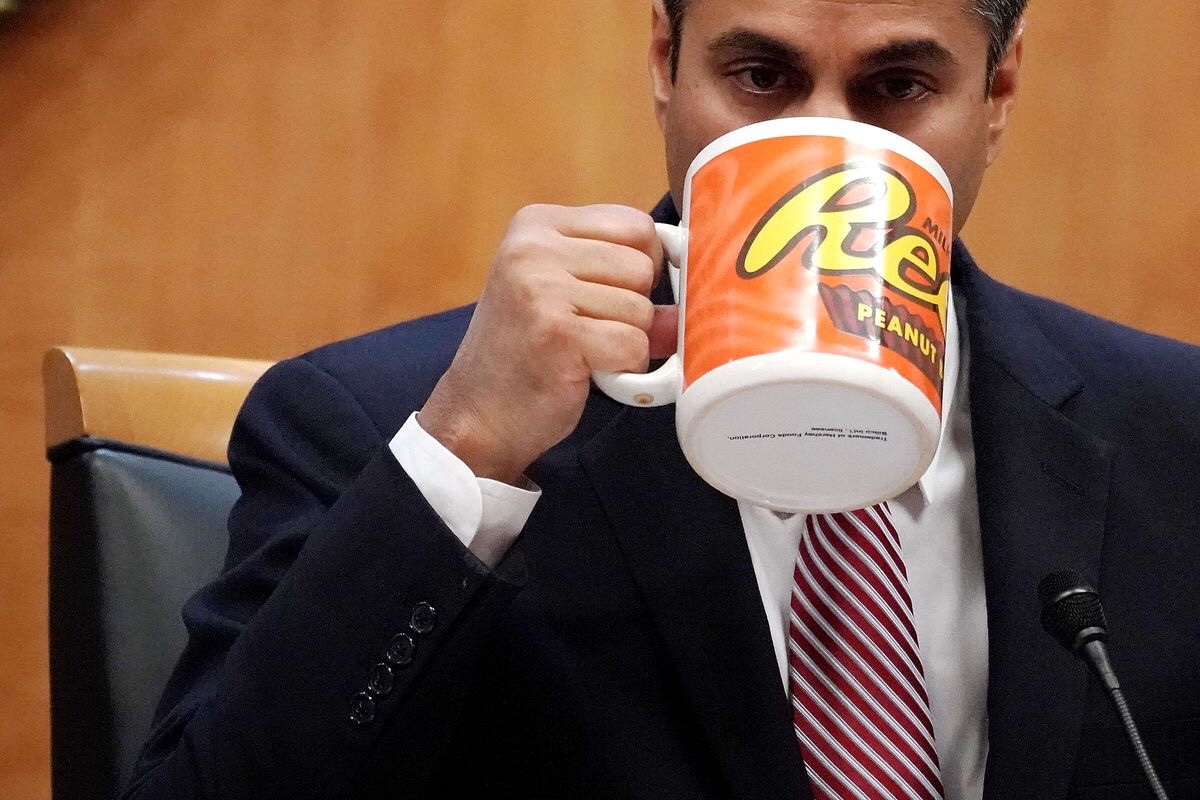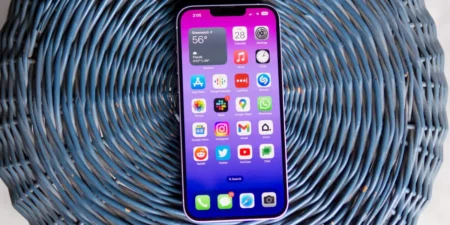Shortly after taking role as FCC chairman, Ajit Pai made it a goal to reverse the net neutrality rules that were passed in 2015. Today, he made that a reality, and completely dismantled net neutrality rules. In a speech, Pai felt it was appropriate to explain why he decided to completely dismantle the rules.
In his speech, Pai brought up some of his regular talking points, saying again that “the internet wasn’t broken in 2015. We weren’t living in a digital dystopia” and that “there was no problem to solve.” He again ignored the fact that internet providers were blocking content and had done so in many various points in recent years.
Pai made it a point to say that it was unfair to regulate internet providers but not regulate websites, like Facebook. “[Websites] regularly block content that they don’t like. They regularly decide what news, search results, and products you see — and perhaps more importantly, what you don’t,” Pai said.
Here’s Pai’s full statement written. Have a read below:
The Internet is the greatest free-market innovation in history. It has changed the way we live, play, work, learn, and speak. During my time at the FCC, I’ve met with entrepreneurs who have started businesses, doctors who have helped care for patients, teachers who have educated their students, and farmers who increased their crop yields, all because of the Internet. And the Internet has enriched my life immeasurably. In the past few days alone, I’ve downloaded interesting podcasts about blockchain technology, ordered a burrito, managed my playoff-bound fantasy football team, and—as you may have seen—tweeted.
What is responsible for the phenomenal development of the Internet? It certainly wasn’t heavy-handed government regulation. Quite to the contrary: At the dawn of the commercial Internet, President Clinton and a Republican Congress agreed that it would be the policy of the United States “to preserve the vibrant and competitive free market that presently exists for the Internet . . . unfettered by Federal or State regulation.”
This bipartisan policy worked. Encouraged by light-touch regulation, the private sector invested over $1.5 trillion to build out fixed and mobile networks throughout the United States. 28.8k modems gave way to gigabit fiber connections. Innovators and entrepreneurs grew startups into global giants. America’s Internet economy became the envy of the world.
And this light-touch approach was good for consumers, too. In a free market full of permissionless innovation, online services blossomed. Within a generation, we’ve gone from email as the killer app to high-definition video streaming. Entrepreneurs and innovators guided the Internet far better than the clumsy hand of government ever could have.
But then, in early 2015, the FCC jettisoned this successful, bipartisan approach to the Internet. On express orders from the previous White House, the FCC scrapped the tried-and-true, light touch regulation of the Internet and replaced it with heavy-handed micromanagement. It decided to subject the Internet to utility-style regulation designed in the 1930s to govern Ma Bell.
This decision was a mistake. For one thing, there was no problem to solve. The Internet wasn’t broken in 2015. We weren’t living in a digital dystopia. To the contrary, the Internet is perhaps the one thing in American society we can all agree has been a stunning success.
Not only was there no problem, this “solution” hasn’t worked. The main complaint consumers have about the Internet is not and has never been that their Internet service provider is blocking access to content. It’s that they don’t have access at all or enough competition. These regulations have taken us in the opposite direction from these consumer preferences. Under Title II, investment in high-speed networks has declined by billions of dollars. Notably, this is the first time that such investment has declined outside of a recession in the Internet era. When there’s less investment, that means fewer next-generation networks are built. That means less competition. That means fewer jobs for Americans building those networks. And that means more Americans are left on the wrong side of the digital divide.
The impact has been particularly serious for smaller Internet service providers. They don’t have the time, money, or lawyers to navigate a thicket of complex rules. I have personally visited some of them, from Spencer Municipal Utilities in Spencer, Iowa to Wave Wireless in Parsons, Kansas. I have personally spoken with many more, from Amplex Internet in Ohio to AirLink Services in Oklahoma. So it’s no surprise that the Wireless Internet Service Providers Association, which represents small fixed wireless companies that typically operate in rural America, surveyed its members and found that over 80% “incurred additional expense in complying with the Title II rules, had delayed or reduced network expansion, had delayed or reduced services and had allocated budget to comply with the rules.” Other small companies, too, have told the FCC that these regulations have forced them to cancel, delay, or curtail fiber network upgrades. And nearly two dozen small providers submitted a letter saying the FCC’s heavy-handed rules “affect our ability to find financing.” Remember, these are the kinds of companies that are critical to providing a more competitive marketplace.
These rules have also impeded innovation. One major company, for instance, reported that it put on hold a project to build out its out-of-home Wi-Fi network due to uncertainty about the FCC’s regulatory stance. And a coalition of 19 municipal Internet service providers—that is, city-owned nonprofits—have told the FCC that they “often delay or hold off from rolling out a new feature or service because [they] cannot afford to deal with a potential complaint and enforcement action.”
None of this is good for consumers. We need to empower all Americans with digital opportunity, not deny them the benefits of greater access and competition.
And consider too that these are just the effects these rules have had on the Internet of today. Think about how they’ll affect the Internet we need ten, twenty years from now. The digital world bears no resemblance to a water pipe or electric line or sewer. Use of those pipes will be roughly constant over time, and very few would say that there’s dramatic innovation in these areas. By contrast, online traffic is exploding, and we consume exponentially more data over time. With the dawn of the Internet of Things, with the development of high bit-rate applications like virtual reality, with new activities like high-volume bitcoin mining that we can’t yet fully grasp, we are imposing ever more demands on the network. Over time, that means our networks themselves will need to scale, too.
But they don’t have to. If our rules deter the massive infrastructure investment that we need, eventually we’ll pay the price in terms of less innovation. Consider these words from Ben Thompson, a highly-respected technology analyst, from a post on his blog Stratechery supporting my proposal:
The question that must be grappled with . . . is whether or not the Internet is ‘done.’ By that I mean that today’s bandwidth is all we [will] need, which means we can risk chilling investment through prophylactic regulation and the elimination of price signals that may spur infrastructure build-out. . . .
If we are “done”, then the potential harm of a Title II reclassification is much lower; sure, ISPs will have to do more paperwork, but honestly, they’re just a bunch of mean monopolists anyways, right? Best to get laws in place to preserve what we have.
But what if we aren’t done? What if virtual reality with dual 8k displays actually becomes something meaningful? What if those imagined remote medicine applications are actually developed? What if the Internet of Things moves beyond this messy experimentation phase and into real-time value generation, not just in the home but in all kinds of unimagined commercial applications? I certainly hope we will have the bandwidth to support all of that![1]
I do too. And as Thompson put it in another Stratechery post: “The fact of the matter is there is no evidence that harm exists in the sort of systematic way that justifies heavily regulating ISPs; the evidence that does exist suggests that current regulatory structures handle bad actors perfectly well. The only future to fear is the one we never discover because we gave up on the approach that has already brought us so far.”[2]
Remember: networks don’t have to be built. Risks don’t have to be taken. Capital doesn’t have to be raised. The costs of Title II today may appear, at least to some, to be hidden. But the consumers and innovators of tomorrow will pay a severe price.
* * *
So what is the FCC doing today? Quite simply, we are restoring the light-touch framework that has governed the Internet for most of its existence. We’re moving from Title II to Title I. Wonkier it cannot be.
It’s difficult to match that mundane reality to the apocalyptic rhetoric that we’ve heard from Title II supporters. And as the debate has gone on, their claims have gotten more and more outlandish. So let’s be clear. Returning to the legal framework that governed the Internet from President Clinton’s pronouncement in 1996 until 2015 is not going to destroy the Internet. It is not going to end the Internet as we know it. It is not going to kill democracy. It is not going to stifle free expression online. If stating these propositions alone doesn’t demonstrate their absurdity, our Internet experience before 2015, and our experience tomorrow, once this order passes, will prove them so.
Simply put, by returning to the light-touch Title I framework, we are helping consumers and promoting competition. Broadband providers will have stronger incentives to build networks, especially in unserved areas, and to upgrade networks to gigabit speeds and 5G. This means there will be more competition among broadband providers. It also means more ways that startups and tech giants alike can deliver applications and content to more users. In short, it’s a freer and more open Internet.
We also promote much more robust transparency among ISPs than existed three years ago. We require ISPs to disclose a variety of business practices, and the failure to do so subjects them to enforcement action. This transparency rule will ensure that consumers know what they’re buying and startups get information they need as they develop new products and services.
Moreover, we empower the Federal Trade Commission to ensure that consumers and competition are protected. Two years ago, the Title II Order stripped the FTC of its jurisdiction over broadband providers. But today, we are putting our nation’s premier consumer protection cop back on the beat. The FTC will once again have the authority to take action against Internet service providers that engage in anticompetitive, unfair, or deceptive acts. As FTC Chairman Maureen Ohlhausen recently said, “The FTC’s ability to protect consumers and promote competition in the broadband industry isn’t something new and far-fetched. We have a long-established role in preserving the values that consumers care about online.” Or as President Obama’s first FTC Chairman put it just yesterday, “the plan to restore FTC jurisdiction is good for consumers. . . . [T]he sky isn’t falling. Consumers will remain protected, and the [I]nternet will continue to thrive.”
So let’s be absolutely clear. Following today’s vote, Americans will still be able to access the websites they want to visit. They will still be able to enjoy the services they want to enjoy. There will still be cops on the beat guarding a free and open Internet. This is the way things were prior to 2015, and this is the way they will be once again.
Our decision today will also return regulatory parity to the Internet economy. Some giant Silicon Valley platforms favor imposing heavy-handed regulations on other parts of the Internet ecosystem. But all too often, they don’t practice what they preach. Edge providers regularly block content that they don’t like. They regularly decide what news, search results, and products you see—and perhaps more importantly, what you don’t. And many thrive on the business model of charging to place content in front of eyeballs. What else is “Accelerated Mobile Pages” or promoted tweets but prioritization?
What is worse, there is no transparency into how decisions that appear inconsistent with an open Internet are made. How does a company decide to restrict a Senate candidate’s campaign announcement video because her views on a public policy issue are too “inflammatory”? How does a company decide to demonetize videos from political advocates without notice? How does a company expressly block access to websites on rival devices or prevent dissidents’ content from appearing on its platform? How does a company decide to block from its app store a cigar aficionado app, apparently because the company perceives that the app promotes tobacco use? You don’t have any insight into any of these decisions, and neither do I. Yet these are very real, actual threats to an open Internet—coming from the very entities that claim to support it.
Look—perhaps certain companies support saddling broadband providers with heavy-handed regulations because those rules work to their economic advantage. I don’t blame them for taking that position. And I’m not saying that these same rules should be slapped on them too. What I am saying is that the government shouldn’t be in the business of picking winners and losers in the Internet economy. We should have a level playing field and let consumers decide who prevails.
* * *
Many words have been spoken during this debate but the time has come for action. It is time for the Internet once again to be driven by engineers and entrepreneurs and consumers, rather than lawyers and accountants and bureaucrats. It is time for us to act to bring faster, better, and cheaper Internet access to all Americans. It is time for us to return to the bipartisan regulatory framework under which the Internet flourished prior to 2015. It is time for us to restore Internet freedom.
I want to extend my deepest gratitude to the staff who have worked so many long hours on this item. From the Wireline Competition Bureau: Annick Banoun, Joseph Calascione, Megan Capasso, Paula Cech, Ben Childers, Nathan Eagan, Madeleine Findley, Doug Galbi, Dan Kahn, Melissa Kirkel, Gail Krutov, Susan Lee, Ken Lynch, Pam Megna, Kris Monteith, Ramesh Nagarajan, Eric Ralph, Deborah Salons, Shane Taylor. From the Office of General Counsel: Ashley Boizelle, Jim Carr, Kristine Fargotstein, Tom Johnson, Doug Klein, Marcus Maher, Scott Noveck, Linda Oliver, and Bill Richardson. From the Wireless Telecommunications Bureau: Stacy Ferraro, Nese Guendelsberger, Garnet Hanly, Betsy McIntyre, Jennifer Salhus, Paroma Sanyal, Jiaming “Jimmy” Shang, Don Stockdale, and Peter Trachtenberg. From the Office of Strategic Planning and Policy Analysis: Eric Burger, Mark Bykowsky, and Jerry Ellig. From the Consumer and Governmental Affairs Bureau: Jerusha Burnett. From the Public Safety and Homeland Security Bureau: Ken Carlberg. And from the Media Bureau: Tracy Waldon.





